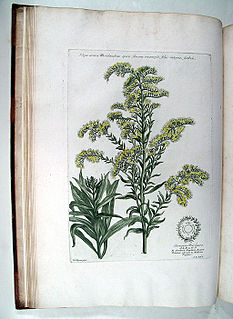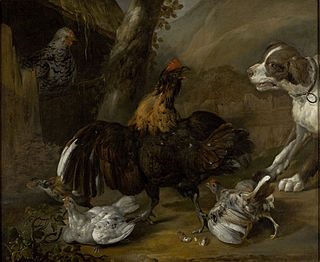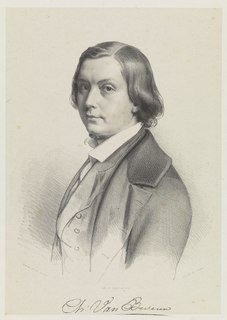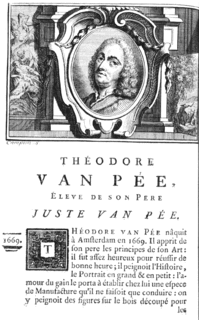
Louis Fabricius Dubourg or Louis Fabritius du Bourg was an historical and academic painter of arcadian landscapes, and an engraver.

Louis Fabricius Dubourg or Louis Fabritius du Bourg was an historical and academic painter of arcadian landscapes, and an engraver.
His parents Jean du Bourg(h) and Elisabeth Burlamacchi married in 1681. Louis Fabrice was baptized on 5 July 1693 in the Walloon church. He was a pupil of Gerard de Lairesse, Gerrit Rademaker (1672-1711) and Jacob van Huysum. In 1718 he became sexton of a small wooden church on Kerkstraat. [1] Around 1726 he was practising foreshortening and may have been a member of an academy; he produced a lot of nude (art) during his life. [2] When he married Eva de Kaarsgieter in 1729 he cooperated with Bernard Picart. [3] [4] After producing several beautiful pictures, some of which may be seen at the Westerkerk, the New Church and town hall of Amsterdam, he exchanged the brush for the graver, and executed some vignettes and other small compositions, and also etched a number of plates from his own designs.
He cooperated with members of the Stadstekenacademie, Amsterdam, as Jacob Folkema, François Morellon, Cornelis Troost, Simon Fokke, Michiel Elgersma and Pieter Tanjé, engravers. He was buried on 22 September 1775 the Amstelkerk, where he had lived most of his life. [5] His collection of pictures and drawings was sold at an auction in 1776.


Bernard Picart or Picard, was a French draughtsman, engraver, and book illustrator in Amsterdam, who showed an interest in cultural and religious habits.
Dubourg or du Bourg is a French surname. Notable people with the name include:

Gerard or Gérard (de) Lairesse was a Dutch Golden Age painter and art theorist. His broad range of skills included music, poetry, and theatre. De Lairesse was influenced by the Perugian Cesare Ripa and French classicist painters such as Charles le Brun, Simon Vouet and authors such as Pierre Corneille and Jean Racine. His importance grew in the period following the death of Rembrandt. His treatises on painting and drawing, Grondlegginge Ter Teekenkonst (1701), based on geometry and Groot Schilderboek (1707), were highly influential on 18th-century painters.
Louis Dubourg may refer to:

Jacob van Huysum was an 18th-century botanical painter from the northern Netherlands who moved to England in 1721.

Jacob Willemszoon Delff the Elder, was a portrait painter active in Delft. He is known by a picture of an 'Archery-feast' in the Hotel de Ville at Delft, dated 1592; and by a Reconciliation of Esau and Jacob, in the Belvedere at Vienna, bearing the date 1584. He also painted The Sportsman's Dinner, and a portrait group of his family. His works display good conception and execution, but are somewhat heavy in colouring.

Jacob Appel (1680–1751) was a Dutch painter active in the 18th century. He was born in Amsterdam in 1680. After studying under Timotheus de Graaf in the years 1690–1692, he was instructed in landscape painting by David Van der Plaas. According to Descamps, he at first imitated the works of Tempesta, but later changed his style, and adopted that of Albert Meijeringh. He painted both landscapes and portraits. He died in 1751 at Amsterdam. He is well known as painter of the famous Petronella Oortman's Dollhouse.

Jacobus Theodorus "Jacob" Abels (1803–1866) was a Dutch painter.

Adriaen, or Jan van Alen (1651–1698) was a painter from the Northern Netherlands. He was born as the son of the animal painter Jacob van Oolen in Amsterdam, with whom his works are sometimes confused. He became an imitator of Melchior Hondekoeter, and his pictures, like those of that master, represent fowls, landscapes, and still-life.

Charles van Beveren (1809–1850), was a Belgian artist, who spent much of his life in Amsterdam.

Albertus Jonas Brandt was a Dutch still life painter. He was the son of a book printer and seller. While working in his father's shop, he became a pupil of J. E. Morel. After Morel's death in 1808, he spent two years with the painter G. J. J. van Os,. When van Os moved to France in 1810, Brandt taught himself, copying Jan van Huysum. In 1814 and 1816 he won prizes in the academy Felix Meritis. Soon he became famous, painting dead game, fruit, and flowers.

Mattheus Ignatius van Bree was a Belgian painter. He was one of the founders of the historical school of painting in Belgium and played an important role as a teacher in the development of 19th-century Belgian art.

Jacob Bunel (1558–1614) was a French painter. The son and pupil of François Bunel, he was born at Blois. He studied at Rome under Federigo Zuccaro, and on returning to France was made painter to the king, and worked with Pourbus and Toussaint du Breuil in the small gallery of the Louvre, burnt in 1661. He was an artist of great merit, and held in much esteem by Henri IV, who employed him at Fontainebleau and other royal residences. He painted 'The Descent of the Holy Ghost' for the chapel of that order in the church of the Grands Augustins at Paris, and for the church of the Feuillants an 'Assumption of the Virgin,' now in the Museum at Bordeaux, both of which pictures have been highly praised. Philip II of Spain, by whom likewise he was esteemed, commissioned him to paint for the cloister of the Escorial forty pictures, all of which have now disappeared. He died in Paris in 1614.

Louis Bernard Coclers was a Southern Netherlandish portrait painter and engraver who worked mainly in Liège, Maastricht, Leiden and Amsterdam.

Adriaan de Lelie was a Dutch painter.

Theodorus van Pee (1668–1746) was an 18th-century painter and art dealer from the Northern Netherlands.

Charles-Dominique-Joseph Eisen was a French painter and engraver.

Simon Fokke (1712–1784) was a Dutch designer, etcher, and engraver. Born in Amsterdam, he was a pupil of J. C. Philips, and was chiefly employed by booksellers to engrave small portraits and vignettes. He died in Amsterdam in 1784. His works include:

Jacques-Nicolas Tardieu, called "Tardieu fils" or "Tardieu the younger", was a French engraver.
Jan Baptist Francken was supposed to be a painter from the Francken family and/or the son of Sebastian Vrancx, but is now considered to have been an error and to have never existed. The confusion was created by the many painters named Francken, some poor attributions, and a portrait by Anthony van Dyck of a certain Johannes Baptist Franck, aged 32, of whom nothing more is known. He is sometimes said to be the same as Hans Francken, another obscure member of the same family.
![]() Media related to Louis Fabritius Dubourg at Wikimedia Commons
Media related to Louis Fabritius Dubourg at Wikimedia Commons